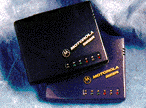

The simplest way to connect a computer to the ISDN network is via an ISDN digital modem. These devices support standard modem interfaces such as the AT command set and RS-232 serial port, but use the digital ISDN network to achieve much higher speeds and greater reliability than analog modems. Most ISDN Digital Modem provides ISDN speed and reliability in an economical device that's as simple to install (External) and use as an analog modem. In addition to the ISDN port, it has an analog voice port, so it can support a standard phone or fax machine along with 64-Kbps data transmission over the ISDN line. There can be options for a 14.4 analog modem, providing backward compatibility with non-ISDN services.ISDN digital modems can support both the ANSI V.120 standard for asynchronous (normal computer transmition) point-to-point communications as well as async-sync (network transmition) Point-to-Point Protocol (PPP) conversion for Internet access. You need this feature if your terminal is going to communicate with networked machines or networks. A built in feature automatically determines which protocol to use for each call. A modem must combine two B channels to boost speeds up to 115-Kbps or 128 Kbps.
An ISDN modem that has a built-in U interface contains equipment called a NT-1 Network Terminator. This will eliminate the need for an external NT-1 box and power supply. The NT-1 is where the phone lines and digital modem interface for transmittion.
Computer telecommunications (ie. a modem) in general falls into these two groups, synchronous and asynchronous, which are refer to as Sync and Async. This has to do with how the hardware (for instance a modem) on each end of the line decide to speak to each other. In general, Sync devices have superior reliability and performance than Async. Personal computers, Macs, and modems are all Async. Sync is generally found in networking equipment such as routers, minis, and mainframes.
ISDN equipment is almost always one or the other. Async ISDN devices, called ISDN modems, plug into a PC serial port and work with your standard communications software, like Plug n' Play, exactly like your modem did. Sync devices, also called ISDN routers, plug into an ethernet Card and provide access for the whole network. Generally, network customers prefer ISDN routers as an effective way to communicate between machines. Your router must be compatible with Pipeline ISDN equipment. Contact your manufacturer for this information.
Network customers will consider Async because they wish to use a Windows NT machine as a TCP/IP router and plug an ISDN modem into the serial port.
Generally, individual customers prefer an ISDN modem connected to the external serial port on the PC. While ISA cards exist, (Internet Service Provider) you will encounter software problems trying to use it, if you can use it at all.
| Digital modem | NT-1 Network Terminator | LAN | Router | ISDN Bridge/Router |
| ISDN Connections 1 | ISDN Connection 2 | Network Connection |
| Personal ISDN Connection | ISDN Phone Lines 1 | ISDN Phone Lines 2 |
| 3Com's ISDN Equipment | Some ISDN cards with an independent test concerning them. |